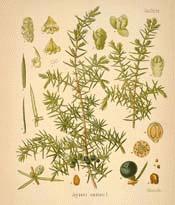Interesting news about absinthe, wich has been banned here in the US for almost as century. It's being allowed back on the shelves, under certain circumstances, apparently. One of the ingredients is..juniper, although I'm not sure that it's the berries of the juniper.
http://www.nbc11.com/news/14784216/detail.html
ALAMEDA, Calif. -- Absinthe, a legendary liquor known for its use and abuse by major literary and artistic figures, is about to hit local store shelves.
An Alameda distillery has been given the green light by the Alcohol and Tobacco Tax and Trade Bureau to sell its version of absinthe, NBC11's Jodi Hernandez reported.
VIDEO:Alameda Distillery Gets Government Go-Ahead For Absinthe | SLIDESHOW: Legendary Liquor, Absnithe, Coming To Bay Area
The drink has been banned for nearly a century because of its 120-proof potency, and fears about its herbal ingredients.
Government officials around the world have long suggested the drink has hallucinogenic properties.
In the early 20th century the drink was banned because officials said it "drove people mad."
Absinthe is a distilled, highly aclohlic anise-flavored spirit made from herbs, including the flowers and leaves of wormwood.
Absinthe is typically green or clear in color.
Absinthe was the drink of choice of 19th and 20th century artists and writers such as Vincent Van Gogh, Emile Zola, Edgar Degas, Edouard Manet, Oscar Wilde, Arthur Rimbaud, Ernest Hemmingway and Pablo Picasso.
Vincent Van Gough reportedly sliced off his ear while drinking it, and legend has it,
the drink turned normal people into homicidal maniacs.
The liquid's so-called maddening qualities were never scientifically proven, Hernandez said.
The U.S. lifted the ban early this year.
The ban on absinthe has been lifted in several European countries as well.
But Alameda's St. George Spirits is the first U.S. company given approval to sell its formula, Hernandez said.
The brandy-based drink is made with nine locally grown herbs.
The drink won't appear on shelves until Dec. 21.
Herbal ingredients in absinthe:
http://www.absinthebuyersguide.com/herbs.html
Common
Wormwood Latin: Artemisia absinthium - It is a member of the daisey family Compositae (Asteraceae).
Use: Source of thujone, absinthe bitterness, produces the green color common in most absinthe.
This herb is easily obtainable at local nurseries and very easy to grow as an ornamental. American sage is a close relative of "common wormwood".
Star Anise Latin: Illicuim verum (also Illicuim floridanum and several other species) - It is a member of the magnolia family, Magnoiliaceae (also Illiaceae).
Use: Counters absinthe bitterness, enhanses the louche.
The plant is highly ornamental perennial and has showy white flowers that become the ornamental seed pod.
Anise Seed Latin: Illicuim verum (also Illicuim floridanum and several other species), for more info see "Star anise".
Use: Counters absinthe bitterness.
Fennel Seed Latin: Foeniculum vulgare - It is a member of the Apiaceae (Umbelliferae) family (parsley family).
Use: Counters absinthe bitterness.
The plant thrives in Mediterranean climates and the flowers are similar to those of the carrot, a flat "umbel".
Angelica Latin: Angelica archangelica (or A. litoralis) It is a member of the Apiaceae (Umbelliferae) family (parsley family).
Use: Counters absinthe bitterness.
It is found from the lands as far north as Finland and extends beyond the Mediterranean.
Hyssop Latin: Hyssopus officinalis - It is a member of the Lamiaceae (Mint) family.
Use: Adds freshness, and produces the green color common in most absinthe.
As with most members of the Mint family hyssop is very aromatic and is easily grown in the garden.
Licorice Latin: Glycyrrhiza glabra - It is a member of the Fabaceae (bean) family.
Use: Counters absinthe bitterness.
It is grown extensively in Russia, Spain, Iran and India. It is one of the most widely consumed herb in the world.
PepperMint Latin: Mentha x piperita - It is a member of the Lamiaceae (Mint) family.
Use: Adds minty freshness, and produces a vibrant green color.
Very easy groundcover to cultivate in fact can become quite invasive in the garden if left alone.
Coriander Latin: Coriandrum sativum - It is a member of the Apiaceae (Umbelliferae) family (parsley family).
Use: Counters absinthe bitterness.
The plant has been grown as a carrot-like perrenial.
Lemon Balm Latin: Melissa officinalis - It is a member of the Lamiaceae (Mint) family
Use: Used to add a lemon/citrus flavor.
Easy to grow as an ornamental ground cover.
Dittany Latin: Origanum dictamnus - It is a member of the Lamiaceae (Mint) family
Use: Counters absinthe bitterness.
Easy to grow, the same genus as oregano.
Juniper Latin: Any of several species in the genus Juniperus. A gymnosperm (coniferous, or "cone bearing" plants).
Use: Counters absinthe bitterness.
A very hardy hardwood perennial evergreen found in Mediteranian climates.
